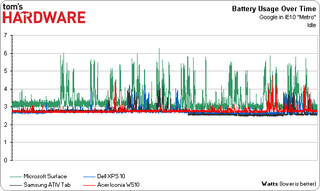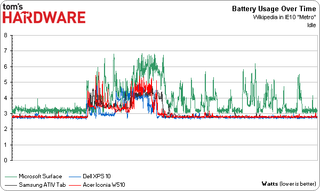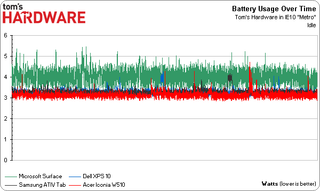Update: Intel Expands Our Battery Testing At CES 2013
We've already shown that x86 competes readily with ARM's simpler architecture when it comes to battery life. We continue our investigation at this year's CES, where Intel came packing its own tests on four current-generation tablets.
Results: Browsing The Web
We opened the Google homepage on all four tablets and then let them drop to an idle state before we began logging battery power data.

The Acer W510, Samsung ATIV Tab, and Dell XPS 10 all consume roughly the same 2.8 W for most of the test. After a while, the two Qualcomm-powered tablets drop to an even lower ~2.5 W, outshining Intel’s Atom. We can't really say that we're surprised by this since Alan came to the conclusion that the ARM-based processor cores are very power efficient when they’re not doing anything. So, the fact that Qualcomm’s Krait-based design excels at idle is pretty much what we expected to see.
More interesting, perhaps, is that Nvidia’s Tegra 3 seems to oscillate in the 3 to 3.2 W range, and regularly spikes above 5 W.
Remember that this isn’t about us (or Intel) running power numbers to show how much better Atom is than its ARM-based competition. Intel admitted to this knowing that it doesn’t necessarily have the winning combination in all tests, and we clearly see Qualcomm with a measureable advantage in the last part of this chart.
Wikipedia

On Wikipedia, the Krait-based SoC appears to be roughly tied with the Atom Z2760 much of the time. During the page render itself, Dell’s specific implementation appears to lead the pack slightly, while the ATIV Tab and W510 appear swap places depending on the spike you’re looking at. Unmistakable, though, is Microsoft's Tegra-based Surface consistently using more power than the other three tablets.
Stay On the Cutting Edge: Get the Tom's Hardware Newsletter
Join the experts who read Tom's Hardware for the inside track on enthusiast PC tech news — and have for over 25 years. We'll send breaking news and in-depth reviews of CPUs, GPUs, AI, maker hardware and more straight to your inbox.
If you sustain the numbers in this chart for any given measure of time, the Surface depletes more of its battery than the competition, necessitating a larger power source to achieve the same overall run time.
Tom's Hardware

Idling on the Tom’s Hardware homepage is slightly more power-intensive than on Wikipedia, as we see both the Qualcomm- and Intel-based tablets hovering just over 3 W. Meanwhile, Tegra 3 is in the 4 W range.
All four tablets appear to dip lower and spike higher than the previously-tested pages, reflecting the more content-heavy nature of Tom’s compared to Google and Wikipedia. Here, though, Krait’s advantage wanes as the heavier load pushes it ever so slightly beyond the Atom’s power usage. However, this difference is minor in comparison to the Tegra 3-based Surface, which appears to use about 1 W more over the entire course of our log.
Current page: Results: Browsing The Web
Prev Page Test Setup And System Specs Next Page Results: Video Playback-
archange Are there any news about the 5th companion core in Tegra being supported under RT? Is software patching feasible?Reply -
abbadon_34 Please tell me the "Metro" reference in IE10 does not mean some forced Win8/Metro style interface. They've lost enough users to other browsers, do they want the rest to jump ship?Reply -
tomfreak whatever it is, 5-10hours of battery life is not good enough. 24hours is the ideal length.Reply -
archange abbadon_34Please tell me the "Metro" reference in IE10 does not mean some forced Win8/Metro style interface. They've lost enough users to other browsers, do they want the rest to jump ship?Reply
It's not "forced". On w8 you get applications specifically designed for touch input. Basically, you have two versions of IE10: the "regular" desktop one and the "Metro" version. The latter has re-placed the URL / search bar at the bottom and has larger, finger-friendly buttons. It also hides its bars for a full-screen browsing experience, which comes in handy on smaller tablet screens. Oh, and I don't use it. Dunno why, but it just doesn't appeal to me :P -
vaughn2k AMD should never had sold the (Imageon) Adreno to Qualcomm.. they should have been gaining business in the mobile business by now... Ruiz was a @*!!@$$...Reply -
ojas Also an interesting read:Reply
Anand's pre-CES article b/w Atom, Krait and the Cortex A15:
http://www.anandtech.com/show/6536/arm-vs-x86-the-real-showdown -
ojas Was interested to read about the predictions for this year.Reply
In order to get the 5-10 hours of gameplay, Tegra 4 would need to run between 3.8 and 7.6 W. We're immensely curious to see if the company can do this.
Anand estimated a 8w TDP for a quad core A15, i think it was the Exynos....with that in mind...i think you're indeed right about your estimate...
The yellow line is the time he's gaming.
Intel claims that its Haswell architecture will be exerting influence in the same space as quad-core Cortex-A15-based devices by the end of the year.
True...Ivy Bridge's already dipped to 7w... -
kyuuketsuki So... you list those 3 SoCs as defining the 2013 tablet space and completely ignore:Reply
1) Samsung's A15-based Exynos
2) AMD's Temash
The heck? -
cangelini KyuuketsukiSo... you list those 3 SoCs as defining the 2013 tablet space and completely ignore:1) Samsung's A15-based Exynos2) AMD's TemashThe heck?We didn't have that hardware on-hand in Vegas, but certainly would like to add those numbers!Reply
Most Popular




